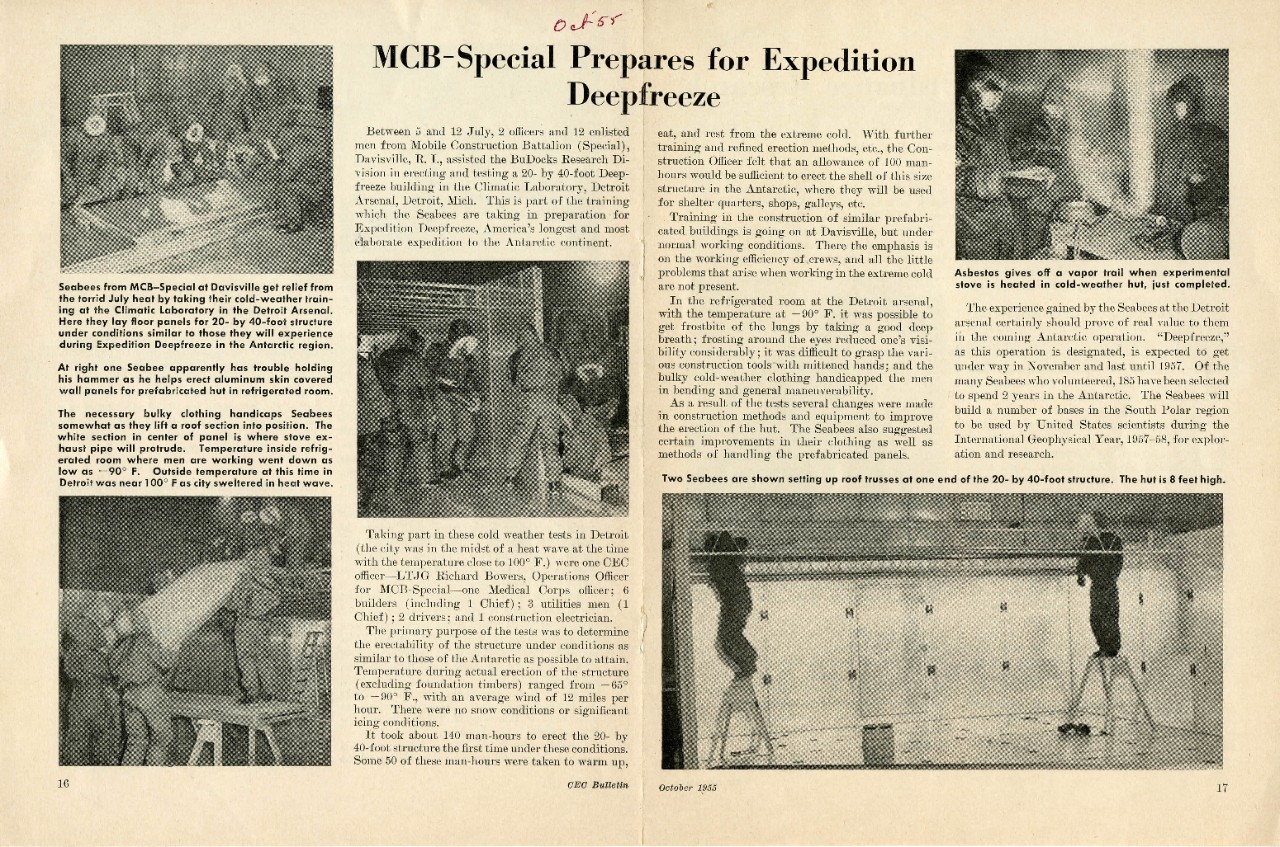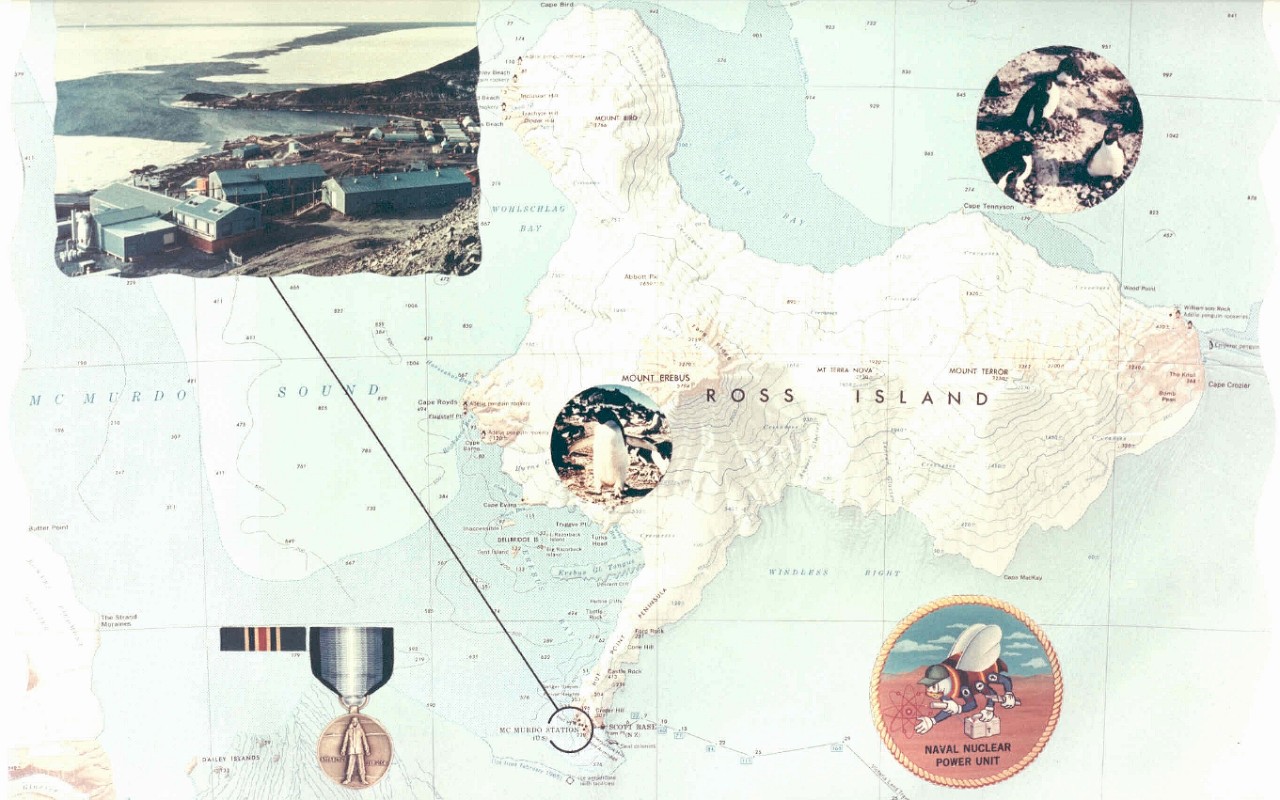Seabee's History in Antarctica
Hardships, Self-Sacrifice, and Espirit de Corps
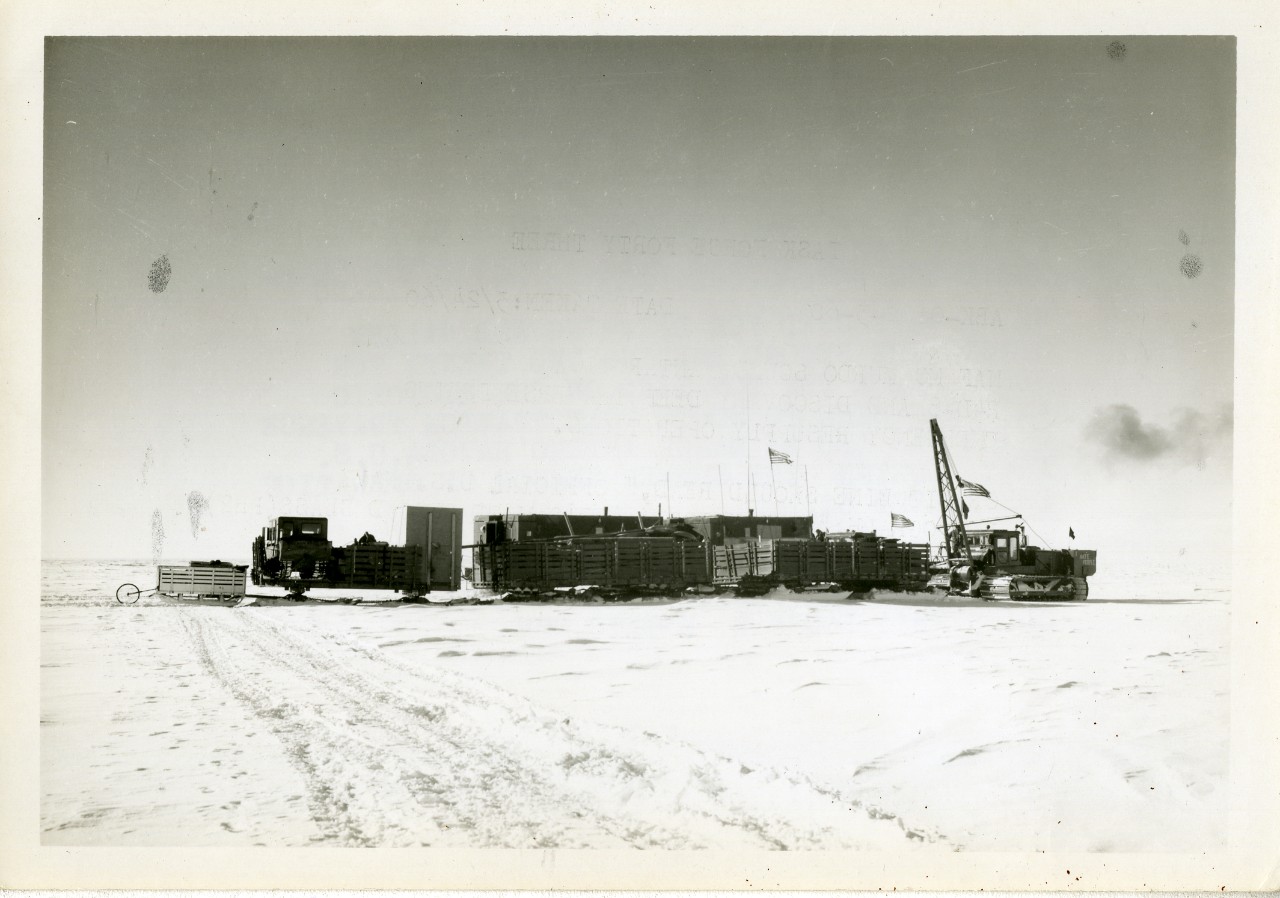
Two D-8 tractors, one pulling two wanigans, the other pulling two twenty-ton sleds and a ten-ton sled on the historic American Byrd to South Pole Station traverse, Taske Force 43 the summer season of Operation Deep Freeze, 1961, 11 January 1961
Why Antarctica?
“The continent of Antarctica comprises about one-tenth of the earth’s land surface, not including the offshore islands and the cold seas that encircle that continent. If the general objective of science is to increase man’s understanding of the earth and of all that is on it--and of the universe of which it is part--then the size of Antarctica is reason enough to study it. When the U.S. Government decided that America should participate in an international program of Antarctic research, the President directed the Secretary of Defense to provide logistic support. The Secretary of Defense selected the Navy as the military service best able to do the job.
The International Geophysical Year was a cooperative, worldwide program of scientific observations that extended from July 1, 1957, to December 31, 1958. Scientists from over 60 nations participated in this massive effort. Twelve of these countries conducted active programs in the Antarctic; Argentina, Australia, Belgium, Chile, France, Japan, New Zealand, Norway, South Africa, the U.S.S.R., the United Kingdom, and the United States.”1
Newspaper article reporting on Naval Mobile Construction Battalion Special preparing for Antarctica deployment, October, 1955
Operation Deep Freeze
Operation Deep Freeze opened the door forever to the vast Antarctic continent with a landmass of over six million square miles, equal to that of the United States and Europe combined. The first phase of the historical Operation Deep Freeze was the United States Navy’s contribution to the support of the International Geophysical Year (IGY), July 1957-December 1958. Fifty-eight nations of varied political philosophies joined together to enlarge man’s knowledge of his physical environment.2
The United States Navy organized Operation Deep Freeze with Naval Mobile Construction Battalion Special, Task Force 43, for their polar expedition. Rear Admiral George J. Dufek led the Naval Support Forces Antarctic as their commander. Task Force 43 consisted of nine ships, three icebreakers, three cargo ships, one tanker, two oilers, and one Naval Mobile Construction Battalion. The battalion was specifically structured to provide construction capability and aircraft support at four designated sites at the South Polar continent.
“Science is the only reason for the existence of Operation DEEP FREEZE. The United States has long been a leader in scientific research. And science has paid its way in the partnership by being one of the sources of America’s strength...The scientific work done in the Antarctic is primarily basic research. This is different from the type of research encountered in military service or in industry; they deal mostly in applied research. The difference between the two kinds of research is rather simple. Basic research is concerned with increasing man’s store of knowledge, not with immediate practical applications. Applied research seeks answers to specific problems."1
Naval Mobile Construction Battalion SPECIAL was commissioned on 18 August, 1955 at Naval Construction Battalion Center Davisville, Rhode Island. The Battalion was composed of an all volunteer force who were selectively chosen based on their mental aptitude, physical fitness, and job comprehension. Several thousand applicants vied for a position on the Antarctica operation, but only the best were chosen. One hundred and seventy-eight enlisted men with fourteen officers made the cut. Joining the Seabees were aviation, supply, medical, dental, and communications personnel to round out NMCB-SPECIAL.2
Due to the limited personnel support facilities in Antarctica and the inclusion of three Air Force, one Coast Guard, two civilian weather service personnel, and two Walt Disney Production personnel, NMCB-SPECIAL’s wintering-over party was reduced to 166 enlisted men, just prior to the departure of the ship.
The main objective of NMCB-SPECIAL was to construct two main and two satellite IGY bases. All designated construction was to be in place and operational prior to the return of Task Force 43, Operation Deep Freeze II, December 1956.
One base was to be established near Admiral Byrd’s 1928 Little America I base on the east perimeter of the Ross Ice Shelf. The other, 450 miles to the west at McMurdo Sound near Mount Erebus. At McMurdo, Seabees were also tasked with the construction of a landing strip for the C-124 Hercules Aircraft as well as other aircraft and a station at the Geographical South Pole. Little America Seabees had the task of constructing Byrd Station, 650 miles to the east in Marie-Byrd Land.
On 20 December, two P2V Neptune and two R5D Skymaster aircraft landed at a hastily prepared ice runway at what was to become William Air Operating Facility. 2 Support personnel as well as ship’s company assisted in off-loading and moving supplies from shipside to temporary staging areas while Seabee construction crews laid out and commenced building the main bases.
Within hours the power plants were operating, toilet facilities were moved indoors, and berthing areas started to take form.
13 months after setting foot on Antarctica, the last Seabee on the continent from the first winter-over boarded a helicopter from Little American V to the CURTIS on 23 January, 1957. Seabees remained a pivotal compliment to the operations of Antarctica until 1994.2
Operation Deep Freeze had numerous phases through 1994. In 1961 the United States signed The Antarctic Treaty which declared that the United States, and 11 other countries, would occupy Antarctica peacefully and for the purpose of research and exploration. This enabled the United States Government to call on the Navy Seabees for numerous summer and winter expeditions to build, reclaim, and fortify research stations.
Station Highlights
Byrd Station
Named after the prolific arctic explorer extraordinaire Rear Admiral Richard E. Byrd, Jr. The station was officially commissioned on 1 January, 1957. “Rear Admiral Richard E. Byrd, U. S. Navy, was the man who proved the absolute necessity of the airplane in Antarctic research. He also can be said to have contributed more than any one man to the widespread use of machines and modern methods of communication in the Antarctic. Byrd first came to Antarctica in 1928 after having been the first man to fly over the North Pole in 1926. The single event for which his first expedition is remembered was his flight over the South Pole on November 29, 1929. Based at Little America on the Bay of Whales, he proved conclusively how effectively the airplane, even with limited range, could be as a tool of exploration”.1 The overall design for the station utilized underground transportation tunnels to move materials between buildings. A New Byrd Station, built 6 miles away from the original station, was constructed underground and lasted until 1972 when the structures collapsed. Now, Byrd Station is rebuilt on the surface and used as a summer field location.
McMurdo Station
McMurdo Station is the largest of the Antarctic stations having been established in December, 1955. It was built on exposed volcanic rock at Hut Point Peninsula on Ross Island - the only solid ground as far south accessible by ship. The station serves as the logistics hub for The Antarctic Program. McMurdo Station is used to conduct a variety of research interests including aeronomy, astrophysics and geospace sciences, biology and ecosystems, geology and geophysics, glaciology, geomorphology, ice cores, and ocean and climate systems. This station is operational year-round.
On March 3, 1962, the U.S. Navy activated the PM-3A nuclear power plant at the station. The unit was prefabricated in modules to facilitate transport and assembly. Engineers designed the components to weigh no more than 30,000 pounds (14,000 kg) each and to measure no more than 8 feet 8 inches (2.64 m) by 8 feet 8 inches (2.64 m) by 30 feet (9.1 m). As a result of continuing safety issues (hairline cracks in the reactor and water leaks), the United States Army Nuclear Power Program decommissioned the plant in 1972. Conventional diesel generators replaced the nuclear power station, with a number of 500 kilowatts (670 hp) diesel generators in a central powerhouse providing electric power. A conventionally-fueled water-desalination plant provided fresh water.
The Richard E. Byrd Historic Monument was erected at McMurdo in 1965.
A navy library with some 17,000 books is maintained at McMurdo, with branches at other U.S. stations in Antarctica. All paperbacks in the library may be checked our permanently.1
Palmer Station
Palmer Station is named for Nathaniel B. Palmer, a Connecticut sealer who, on 17 November 1820, during an exploratory voyage ranging southward from the South Shetland Islands, may have been the first person to see Antarctica. (British and Russian ships were in the area at about the same time.)
The original station was built in 1965. In 1967, the U.S. Navy began construction of the current larger and more permanent station approximately a mile east of the original site. The first building at the new station, the biology laboratory, opened its doors to science in 1970.
Palmer Station is superbly located for biological studies of birds, seals, and other components of the marine ecosystem. It has a large and extensively equipped laboratory and sea water aquaria. In 1990 it was designated by the National Science Foundation as a long term ecological research (LTER) site.
Today, two main buildings and several smaller structures make up Palmer Station and provide housing and research facilities for scientists and support personnel. Of the three U.S. Antarctic stations, Palmer is the only one that is accessed routinely during the winter.
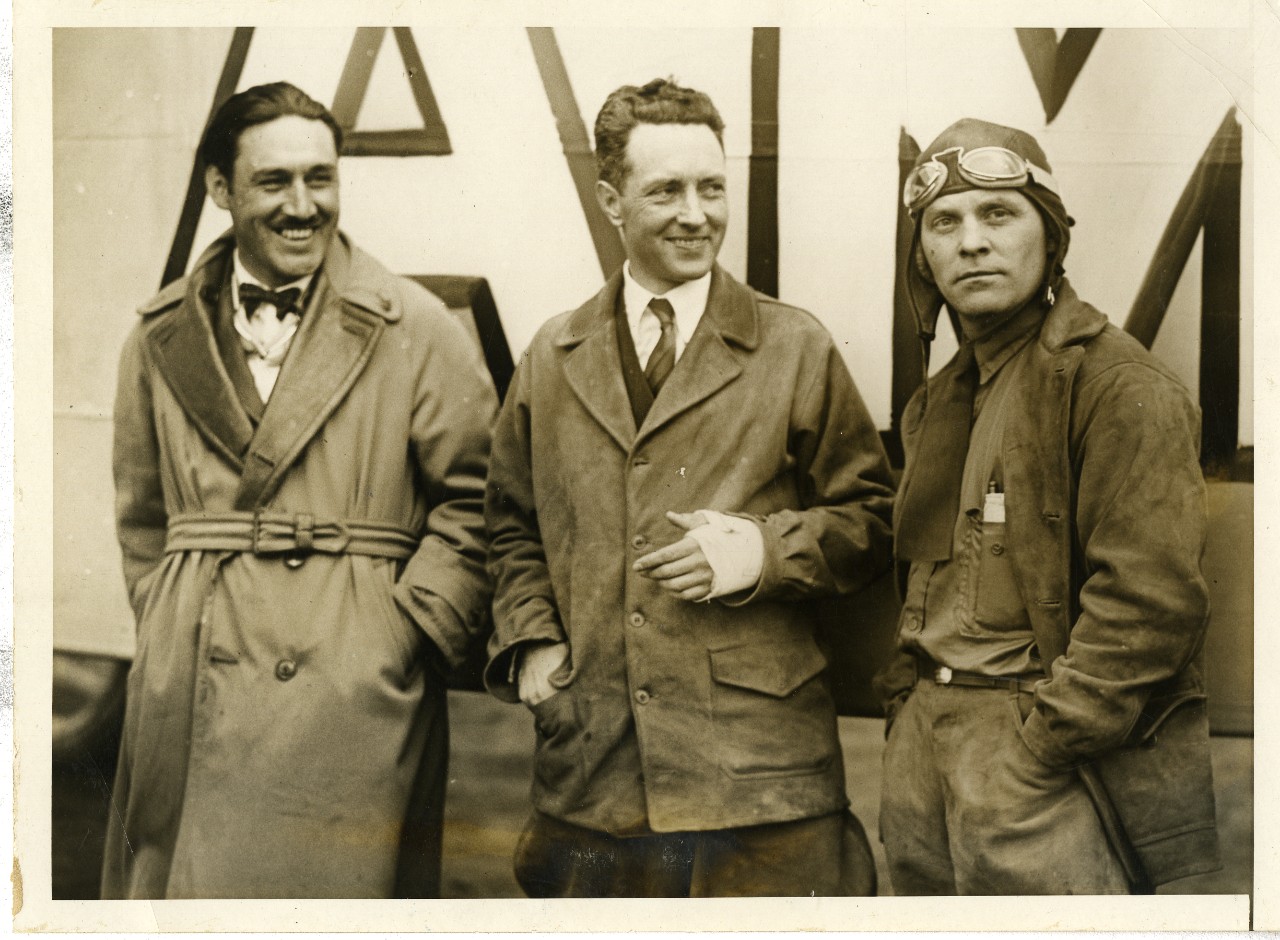
Rear Admiral Richard E. Byrd (middle), alongside Leuitenant George Noville (right), and Bert Acosta (left) prior to their flight to Paris in aircraft "America", circa 1927
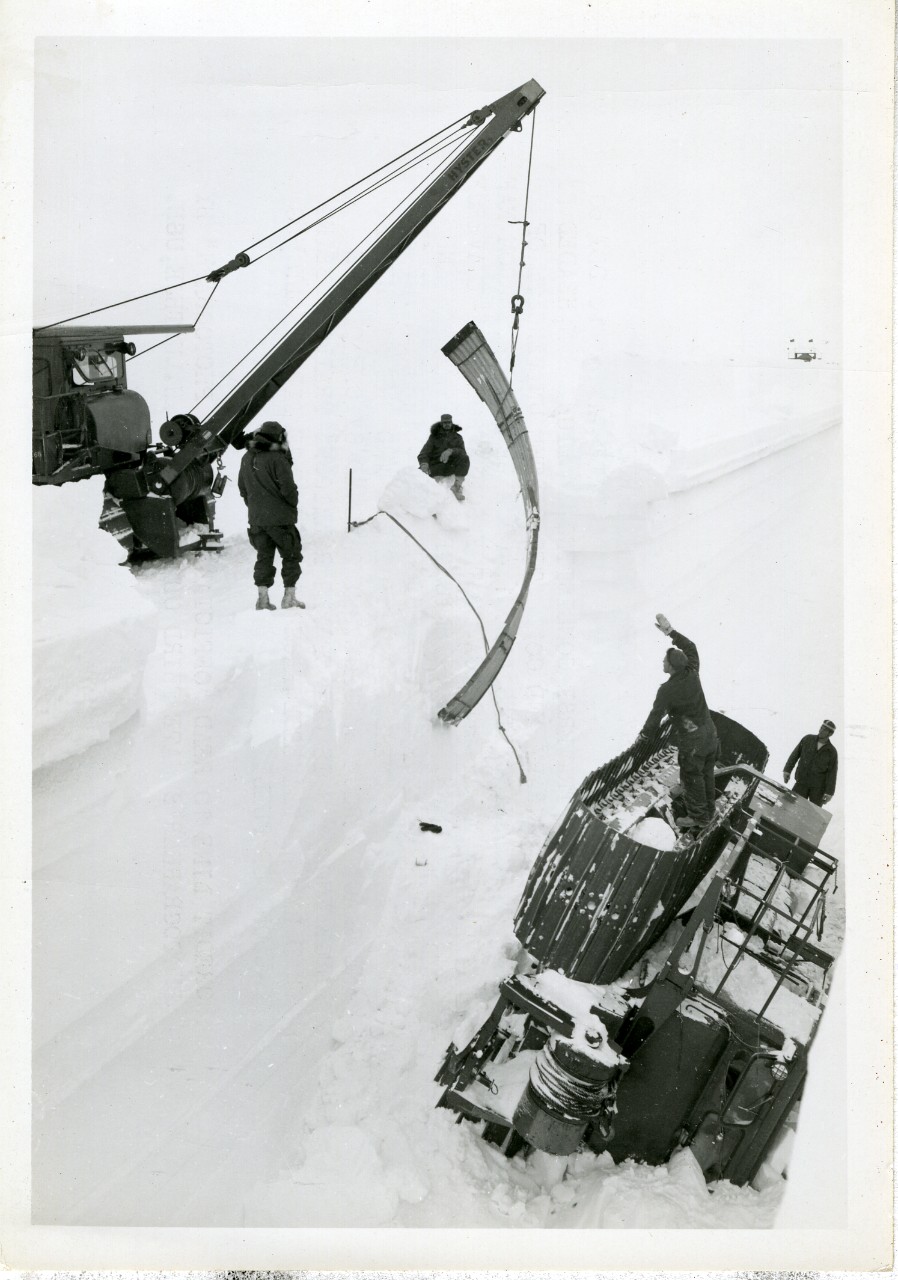
Members of Task Force 43 use a cable hoist on a D-8 tractor to lift the 14-foot arches off of the tractor that fell into the trench, New Byrd Station, Antarctica, 21 January, 1961
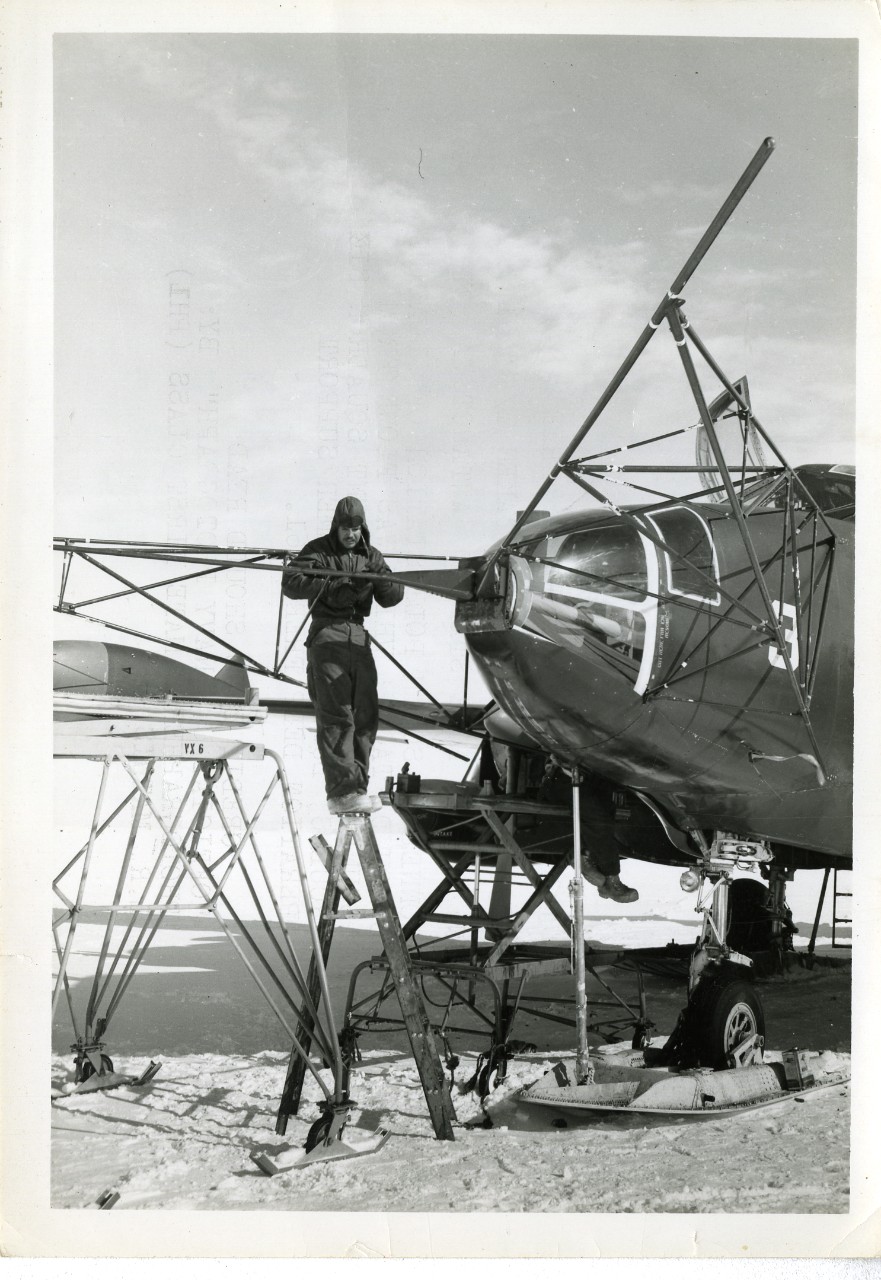
AM1 William W. Chastain from Carmi, Illinois tightening the nose mount bolts on the Air Retriever on P2V-7 Ski Aircraft Buno, 25 January 1961
South Pole Station
Seabees began construction on the first South Pole Station during the summer season of 1956-1957, almost 20 years before their famous South Pole Dome. Early construction on Antarctica supported the International Geophysical Year (IGY), a first coalition of 39 nations committed to an 18-month systematic investigation of the Earth’s environment using the latest technologies. Along with seven ships from the Atlantic Fleet and an air wing with extreme cold experience, US Navy support of IGY – designated Task Force 43 – included a special unit of Seabees created to build-up the facilities required to do the science. Seabees were specifically tasked with constructing research facilities between the Ross Ice Shelf and the South Pole.
Under the joint leadership of Dr. Paul Siple and Naval Lieutenant John Tuck, 18 men spent the first winter at the South Pole in a station built by the Seabees in the austral summer of 1956-57. Cargo was dropped by the United States Air Force planes. On 23 January, 1957, an offical dedication ceremony for the South Pole station was held at McMurdo Station with speeches, marines in full dress uniforms, and a radio proclamation from President Eisenhower.
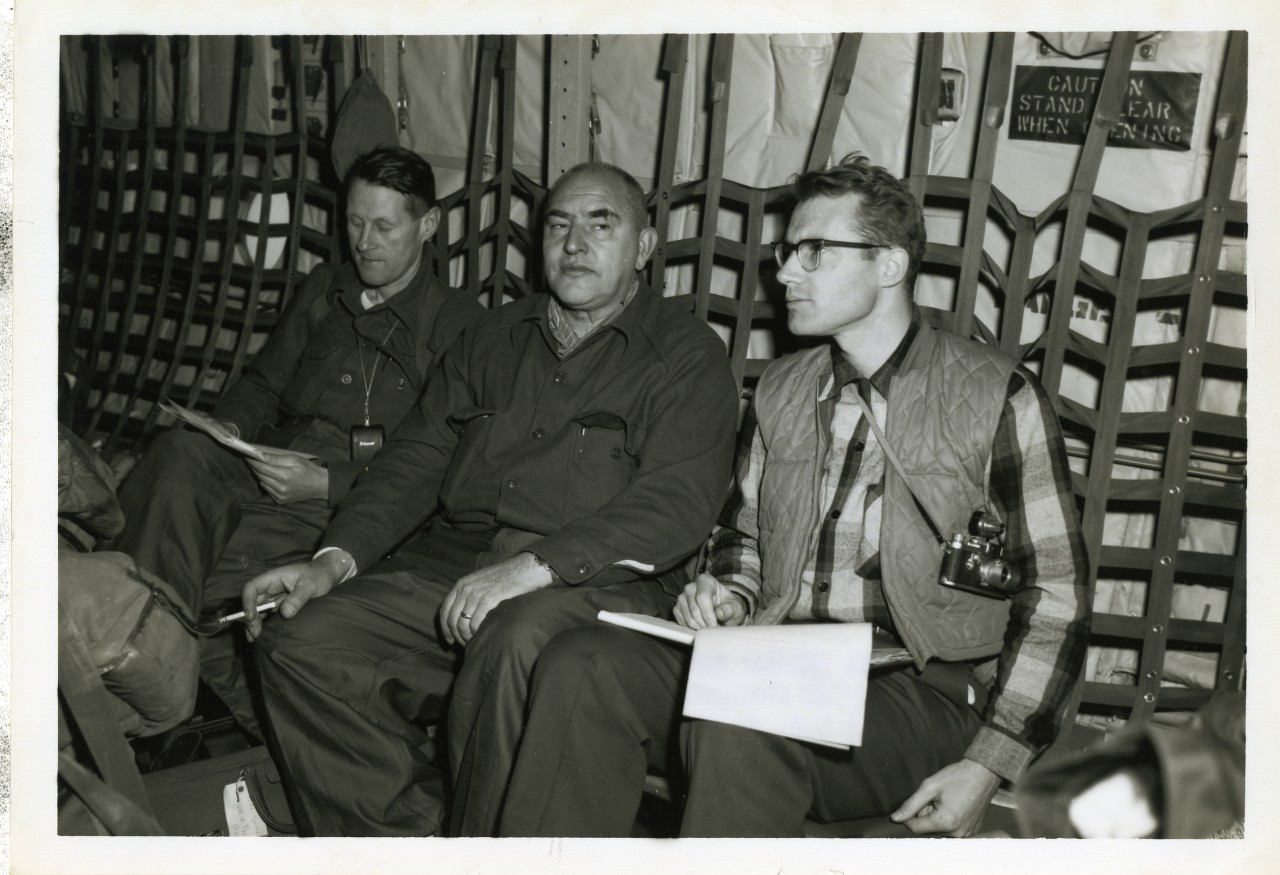
Dr. Tore Gjelsvik, Director of the Norwegian Polar Institute with Dr. Paul A. Siple, First Scientific Leader to winter-over at Amundsen-Scott South Pole Station on Operation Deep Freeze I, accompanied by Mr. Philip M. Smith, Senior United States Antarctic Research Program Representative, 30 October, 1961
Additional Resources
Works Cited
(1) RG 05 Geogrphical Files, Antarctica General, Welcome Aboard Packet, Operation Deep Freeze, United States Navy Seabee Museum Archive
(2) RG 01 Naval Construction Force, Naval Mobile Construction Battalion SPECIAL, 1955-58, Box 01, Folder 01, JO3 Jason Torres and Bill Stroup, United States Seabee Musem Archive

